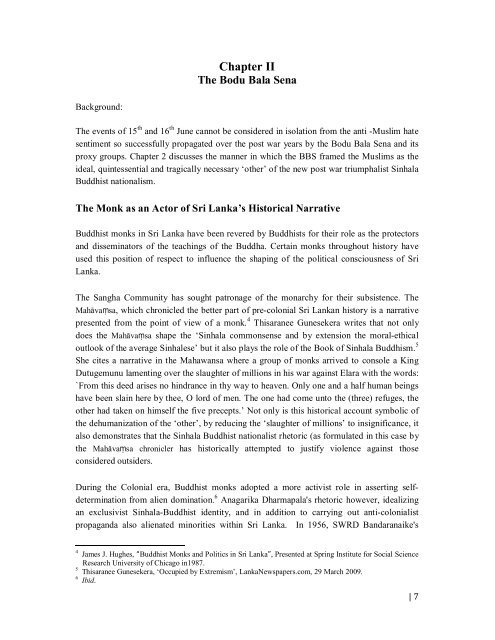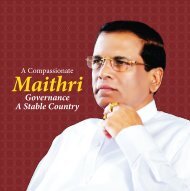You also want an ePaper? Increase the reach of your titles
YUMPU automatically turns print PDFs into web optimized ePapers that Google loves.
Chapter II<br />
The Bodu Bala Sena<br />
Background:<br />
The events of 15 th and 16 th June cannot be considered in isolation from the anti -Muslim hate<br />
sentiment so successfully propagated over the post war years by the Bodu Bala Sena and its<br />
proxy groups. Chapter 2 discusses the manner in which the BBS framed the Muslims as the<br />
ideal, quintessential and tragically necessary ‘other’ of the new post war triumphalist Sinhala<br />
Buddhist nationalism.<br />
The Monk as an Actor of Sri Lanka’s Historical Narrative<br />
Buddhist monks in Sri Lanka have been revered by Buddhists for their role as the protectors<br />
and disseminators of the teachings of the Buddha. Certain monks throughout history have<br />
used this position of respect to influence the shaping of the political consciousness of Sri<br />
Lanka.<br />
The Sangha Community has sought patronage of the monarchy for their subsistence. The<br />
Mahāvaṃsa, which chronicled the better part of pre-colonial Sri Lankan history is a narrative<br />
presented from the point of view of a monk. 4 Thisaranee Gunesekera writes that not only<br />
does the Mahāvaṃsa shape the ‘Sinhala commonsense and by extension the moral-ethical<br />
outlook of the average Sinhalese’ but it also plays the role of the Book of Sinhala Buddhism. 5<br />
She cites a narrative in the Mahawansa where a group of monks arrived to console a King<br />
Dutugemunu lamenting over the slaughter of millions in his war against Elara with the words:<br />
`From this deed arises no hindrance in thy way to heaven. Only one and a half human beings<br />
have been slain here by thee, O lord of men. The one had come unto the (three) refuges, the<br />
other had taken on himself the five precepts.’ Not only is this historical account symbolic of<br />
the dehumanization of the ‘other’, by reducing the ‘slaughter of millions’ to insignificance, it<br />
also demonstrates that the Sinhala Buddhist nationalist rhetoric (as formulated in this case by<br />
the Mahāvaṃsa chronicler has historically attempted to justify violence against those<br />
considered outsiders.<br />
During the Colonial era, Buddhist monks adopted a more activist role in asserting selfdetermination<br />
from alien domination. 6 Anagarika Dharmapala's rhetoric however, idealizing<br />
an exclusivist Sinhala-Buddhist identity, and in addition to carrying out anti-colonialist<br />
propaganda also alienated minorities within Sri Lanka. In 1956, SWRD Bandaranaike's<br />
4 James J. Hughes, “Buddhist Monks and Politics in Sri Lanka”, Presented at Spring Institute for Social Science<br />
Research University of Chicago in1987.<br />
5 Thisaranee Gunesekera, ‘Occupied by Extremism’, LankaNewspapers.com, 29 March 2009.<br />
6 Ibid.<br />
| 7




